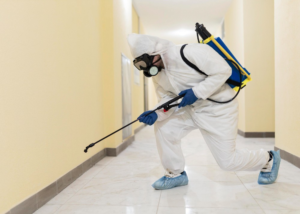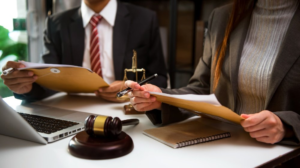A pest infestation can make a living space unbearable, and some species of insects and rodents can cause severe health problems or even death. Exterminators are the professionals who help eradicate these unwanted intruders.
However, exterminators’ services are largely limited to aggressive eradication methods that don’t address the root causes of the problem. A better option is pest control services, which focus on prevention instead of treating symptoms. Contact Exterminator Bakersfield now!

Exterminators are responsible for pests in homes, businesses, and buildings. They must be able to read and understand technical information and follow safety guidelines when working with chemicals. They must also maintain detailed records of all treatments and other relevant financial transactions. Exterminators must have good bookkeeping skills to manage their business effectively.
While there are many different types of pests, all exterminators share the same ultimate goal: to eliminate unwanted insects and animals. Some professionals specialize in specific areas such as rodent control, bed bug removal or termite treatment. Others offer more general solutions like fumigation and insecticide spraying. While some exterminators use natural or organic solutions, most rely on a combination of chemicals and traps to remove pests from properties.
A typical day for an exterminator begins with a client consultation. This is when the technician will examine a property and discuss a pest problem, its origins and what measures are required to solve it. The cost for this service will vary depending on the size of a home and the extent of the pest infestation. Some pest control companies will use square footage as the main factor in setting their prices, while others will include additional factors such as the type of pest and their resistance to certain chemicals.
Once the customer agrees to the terms of the contract, an exterminator will visit a property and carry out the required treatments. They will typically begin with a general inspection to look for signs of pests as well as their droppings and nests. They may also inspect the surrounding area to determine if the pests are travelling from another location and how far they have spread.
An exterminator will often use chemicals in their work, but they are not always required to provide a warranty or guarantee for their services. This is mainly because they are providing only a temporary solution and are not getting to the root of the problem. A true pest control professional will recognize that a long-term preventative approach is the best way to reduce recurrence of pest problems.
Education and Training Requirements
Whether seeking employment as an exterminator for a pest control company or planning to start one’s own business, this is a career that requires specific education and training. The first step is to understand the licensure and certification requirements in one’s state or region, which vary by location but generally involve passing examinations that test knowledge of pest control techniques, safety precautions, and regulatory standards.
In addition, some states require that aspiring exterminators complete job-specific educational programs and/or apprenticeships to gain experience and learn the skills necessary for success. These types of programs also offer the opportunity to practice using specialized tools, equipment, and chemicals commonly used in the industry.
Because pests can pose serious health and safety risks, exterminators are trained to follow strict adherence to the proper application of chemical treatments and other pest control measures. The ability to identify potential entry points into a building or property and to quickly detect signs of pest infestation are other essential skills for those who wish to succeed in this field.
Exterminators who are hired by companies or private individuals must be able to communicate with the people they serve and explain their treatment plans. In residential settings, this may include communicating with homeowners and providing recommendations for preventing future pest problems. In commercial settings, such as restaurants and hotels, exterminators must be able to work around customers while maintaining a professional demeanor.
Some states require that aspiring or practicing exterminators obtain liability insurance to protect against financial loss in the event of an accident while working on a job site. This type of insurance can be obtained through a number of insurers, and is typically inexpensive. Additionally, obtaining insurance coverage will protect an exterminator’s reputation as a responsible, professional pest control specialist.
For those who plan to start their own pest control business, establishing strong bookkeeping skills is an important step for long-term financial success. This includes keeping accurate records of work hours, pest control methods implemented, and all other financial transactions. Likewise, staying abreast of ongoing advancements in pest control technologies and software can help an entrepreneur expand his or her business and maintain competitiveness within the industry.
Work Environment
The work environment for an exterminator can be both physically and mentally demanding. They must be able to complete their duties in a range of environments, including homes, businesses and warehouses. They also need to be able to work alone or as part of a team, depending on the size of the project. Some exterminators find the job stressful because they must adhere to strict safety protocols and are often under time pressure to finish their work.
The Department of Health and Mental Hygiene is committed to maintaining a workforce free from discrimination and harassment based on legally protected characteristics, including but not limited to an individual’s sex, race, color, national origin, religion, age, sexual orientation, veteran status, gender identity or expression. Applicants must meet the minimum qualifications for this position and successfully pass a background check and drug screening to be considered for the job.
Inspect premises and investigate complaints of infestation. Determine the appropriate method of extermination or pest prevention (e.g., stoppage efforts) to be used. Order necessary supplies and equipment and supervise the preparation of the various poisons employed in exterminating operations. Keep related records and make reports of exterminating activities.
Job Outlook
An exterminator works to eliminate and control undesirable insects, rodents and other pests that damage buildings or threaten public health and safety. Some of the more common pests that these workers get rid of include mice, rats, cockroaches, fleas, bedbugs, ants and termites. These professionals also work to remove birds and snakes from residential and commercial properties, when necessary.
A high school diploma is usually a minimum requirement for this career, although some employers prefer applicants with at least a GED certificate or a bachelor’s degree in a field such as biology or chemistry. On-the-job training is often provided to new hires. Beginners may be assigned to help an experienced worker or may attend classroom-based or home-study courses in pest control. Those who deal with termites, for example, may need to take courses in carpentry or be trained to use specialized equipment such as drills and spraying machines.
Depending on the type of pest, an exterminator decides on the best way to eliminate it. A spray or liquid might be effective against some types of pests, while traps or poisoned baits are usually used to get rid of others. These workers often advise customers on ways to prevent pests from returning, including sealing holes, destroying nesting areas and removing food sources.
Exterminators are often self-employed, but some work for government agencies or private businesses such as restaurants and food stores. They must be able to work outdoors, in extreme weather conditions, and on ladders to reach the upper levels of buildings where many pests like to hide. In addition, they are required to wear protective clothing such as respirators and goggles when working with pesticides. As a result, this job can be very dangerous. CareerExplorer gives this career a D employability rating, meaning that it has weak employment opportunities.




